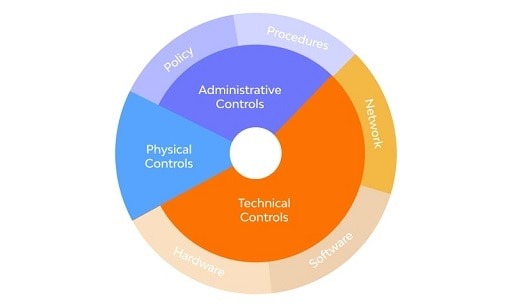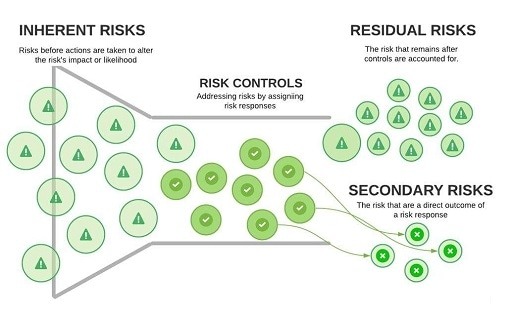Of course, though clever, cybercriminals are not bulletproof. Most of the successful attacks only succeed because of poor cybersecurity. Boosting your security helps in barring intruders from your network.
A good strategy of defense-in-depth can match your determination and persistence with that of the threat actors and wear them out. You can learn about the benefits of defense in depth and how to implement it to improve your cybersecurity posture.

What is Defense in Depth?
Defense in depth is a cybersecurity strategy that uses multiple layers of security controls to defend an organization’s network, systems, and data against cyber threats. The concept of depth here means that in case one layer of security fails, other layers will be defending.
It involves a set of different security measures, including firewalls, intrusion detection/prevention systems, anti-virus/malware software, access controls, data encryption, and employee training. Organizations can make their systems more resistant to cyber-attacks and reduce the possibility of a successful breach by layering controls.
Secondly, DiD is a cybersecurity strategy involving multiple layers of security mechanisms to guard digital assets. This approach contrasts with dependence on a single mechanism for security; in case there is a vulnerability and it is exploited, the attacker gets network access. In a situation where multiple defenses are set up, cybercriminals have to go through various barriers that impede their progress.
Theoretically, this idea comes from the field of military strategy. The whole idea behind DiD is not to slow an attacker down but to make the defensive layer thick to defeat the attacker. This means that cybersecurity involves many layers of security towards detecting, preventing, and responding to different attack forms using human and technological resources.
How Does Defense in Depth Work?
DiD works through several layers of security defenses set up to prevent or mitigate a cyberattack. Some of the layers include firewalls, antivirus, intrusion detection, encryption, access controls, security awareness training, incident response plans, and others in both technical and human resource areas.
Every layer in defense in depth adds a different obstacle for the attacker to block or delay when the attacker penetrates the network. An attacker might successfully avoid one layer but may still face another layer of security barriers before finally accessing his target. This makes it hard to reach objectives while allowing the defenders more time to get back and respond.
You can also read: Malware Removal: Best Antivirus Software for 2023
Defense in depth is not an event; it is a process through which vulnerabilities are to be continuously found, and the network needs to be kept under observation against suspicious activities while updating or improving those security layers.
This way, even if the attacker successfully bypasses one or more security layers, they face significant obstacles until they reach their target, while defenders have more time to respond and contain the attack. There are three components of a DiD cybersecurity strategy: technical, administrative, and physical controls.
Technical Controls
Technical controls are the technologies designed to help protect the digital assets on your network. Examples include firewalls, encryption, and intrusion detection systems hardware and software solutions designed to help protect your data.
Through mechanisms for control and prevention against unauthorized access to your system, technical controls play a huge role in the process of DiD. Otherwise, cyber thugs can easily bypass all entry protocols without much hindrance. It also helps in protecting data both at rest as well as when in motion.
You can also read: Linux vs Windows Difference: Which Is The Best Operating System?
Administrative Controls
Administrative controls are those controls set to manage user behavior, hence improving the security of digital assets. Controls will provide policies and procedures to be followed by users in preventing actions that could compromise the security of your data.
One of the most important aspects of administrative controls is that they can help eliminate insider threats. Users on your network can perform actions that might knowingly or unknowingly open up vulnerabilities on your network. By having administrative controls, such actions can be detected and stopped before they lead to any harm.
Physical Controls
Physical controls entail different mechanisms and techniques for disallowing unauthorized physical access to the network and digital assets. Examples are biometric systems, digital locking, intrusion detection sensors, and cameras.
With physical control, you would be certain that only authorized personnel can gain access to various physical places within your organization and equipment stored in them for work. This will also be of utmost importance within the DiD as physical breaches will result in disastrous consequences for network security.
How to Implement Defense in Depth Strategy
-
Audit Your Network
Conducting a comprehensive audit is a crucial first step in effectively securing your network. This involves identifying all the applications in your system, understanding how they function, and pinpointing any vulnerabilities they may have. By conducting such an audit, you gain a better understanding of the operational details of your network, particularly with regards to security.
-
Classify and Prioritize Critical Data
To effectively protect your data, it’s important to first classify it based on its sensitivity and criticality. This process is known as data classification. Once you have classified your data, you can then prioritize it based on its level of importance to your organization.
To classify your data, you need to establish clear criteria and guidelines for grouping similar data together. This can help you allocate your security resources more effectively and ensure that your most critical data receives the highest level of protection.
-
Implement Multiple Firewalls
Firewalls play a crucial role in a defense in depth strategy by filtering incoming and outgoing traffic in your network for abnormalities. To implement firewalls, you need to establish perimeters that determine which traffic is allowed to enter the network. Any traffic that does not meet these criteria will be blocked.
In a defense in depth approach, having multiple firewalls adds an extra layer of protection against attack vectors, even if they manage to bypass certain vulnerabilities.
-
Develop Endpoint Security
Endpoints are often the primary targets for attackers to gain entry into a network. Incorporating endpoint security into your defense in depth strategy fortifies your access points, making them more secure. An additional layer of protection can be achieved through the implementation of endpoint detection and response (EDR) systems, which are capable of detecting threats in real-time and triggering defenses automatically.
Advantages of Defense in Depth
Implementing a defense in depth strategy can provide various advantages, including the element of surprise for attackers. Cybercriminals may assume that they have successfully bypassed security measures, but with multiple layers of protection, they will encounter additional obstacles.
You can also read: The Mobile App Development Process
Other benefits of a DiD security framework include increased resilience against attacks, reduced likelihood of a successful breach, improved incident response and recovery, and better protection of critical data and assets. Additionally, a DiD approach can help organizations meet compliance requirements and enhance their reputation by demonstrating a commitment to security.
Here are some of the benefits of a DiD security framework.
-
Active Isolated Security Zones
Isolated security zones are separate security mechanisms within a network that operate independently. Rather than being connected, each functions as an individual entity. This means that if an attacker breaches one zone, the others can still function because they are not dependent on one another.
By offering isolated security systems, defense in depth can enhance the security of your network. Even if an intruder succeeds in bypassing a particular security defense, they will soon discover that there are other active defenses to contend with.
-
Resistance Against Multiple Threats
Even with accurate predictions of cyber threats, attackers can change their tactics to bypass the defenses in place. Implementing a defense in depth strategy allows for the creation of multiple defenses that can address different threat vectors. Rather than relying on a single defense mechanism, a combination of defenses secures even the areas that may have been overlooked or deemed less critical.
-
Monitoring Network Activities
Many cyberattacks are successful due to the absence of effective monitoring to detect suspicious actions within systems. Contrary to the assumption that DiD is just about protecting threat vectors, it also detects developing threats and stops them before they escalate. This is possible with threat monitoring and prevention tools.
-
Enforcing Data Privacy
In very dynamic cyberspace, ensuring the greatest level of data privacy is a must. Defense in depth is one of the few cybersecurity solutions that can safeguard data at rest and in transit using data hashing and encryption.
You can also read: Essential IT Security Tech for Businesses
Data backup, an essential component of a DiD strategy, improves data privacy. If you experience a data breach or attack, your DiD solution’s backup feature can assist you in restoring your data.
Create Robust Security With a Defense in Depth Strategy
To get the most effective cybersecurity framework, go big or go home. Defense in depth requires you to construct several defenses to secure your data, leaving no stone untouched.
Cybercriminals will not stop until they have achieved their objectives. If you only have one or two defenses, you make it far too simple for them. A DiD approach is developing many systems to secure your territory, even if they are redundant.
Would you like to read more about How to stop Cyberattacks-related articles? If so, we invite you to take a look at our other tech topics before you leave!










